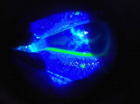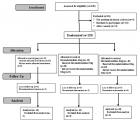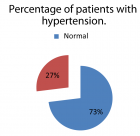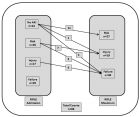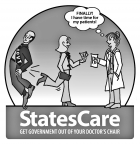Abstract
Research Article
Left ventricular ejection fraction and contrast induced acute kidney injury in patients undergoing cardiac catheterization: Results of retrospective chart review
Firas Ajam*, Obiora Maludum, Nene Ugoeke, Hetavi Mahida, Anas Alrefaee, Amy Quinlan DNP, Jennifer Heck-Kanellidis NP, Dawn Calderon DO, Mohammad A Hossain* and Arif Asif
Published: 15 November, 2019 | Volume 4 - Issue 3 | Pages: 195-198
Background: Contrast-induced acute kidney injury (CI-AKI) is an important cause of increasing the hospital stay and in-hospital mortality. By increasing intra-renal vasoconstriction, left ventricular ejection fraction (LVEF) can increase the risk of CI-AKI. We sought to investigate whether LVEF can impact the incidence of CI-AKI after cardiac catheterization and whether it can be used to predict CI-AKI.
Methods: Patients underwent cardiac catheterization from December 2017 to February 2018 at Jersey Shore University Medical Center were enrolled in the study. Contrast-induced acute kidney injury (CI-AKI) was defined as an increase in serum creatinine of ≥ 0.5 mg/dL or an increase of ≥ 25% from the pre-procedure value within 72 hours post-procedure. The maximum allowable contrast dose was calculated using the following formula: (5* (weight (kg)/creatinine level (mg/dL)). A multivariable logistic regression analyses, controlling for potential confounders, were used to test associations between LVEF and CI-AKI.
Results: 9.6% had post catheterization CI-AKI. A total of 18 out of 44 (44%) of patients who had CI-AKI also had ongoing congestive heart failure. No statistically significant association found neither with maximum allowable contrast (p = 0.009) nor ejection fraction (p = 0.099) with the development of CI-AKI.
Conclusion: In spite of the fact that no statistically significant relationship found between the percentage maximum contrast dose and the ejection fraction with the post-procedure CI-AKI, we heighten the essential of employing Maximum Allowable Contrast Dose (MACD) and ejection fraction in patients undergoing PCI to be used as a clinical guide to predict CI-AKI.
Read Full Article HTML DOI: 10.29328/journal.jccm.1001066 Cite this Article Read Full Article PDF
Keywords:
Contrast nephropathy; Left ventricular ejection fraction; Acute kidney injury
References
- Tsai TT, Patel UD, Chang TI, Kennedy KF, Masoudi FA, et al. Contemporary incidence, predictors, and outcomes of acute kidney injury in patients undergoing percutaneous coronary interventions: insights from the NCDR Cath-PCI registry. JACC CardiovascInterv. 2014; 7: 1-9. PubMed: https://www.ncbi.nlm.nih.gov/pubmed/24456715
- Weisbord SD, Palevsky PM. Contrast-induced acute kidney injury: short and long-term implications. Semin Nephrol. 2011; 31: 300-309. PubMed: https://www.ncbi.nlm.nih.gov/pubmed/21784279
- Pakfetrat M, Malekmakan L, Zahra Salmanpour, Mohammad Hossein Nikoo, Peyman Izadpanah, Comparison of Normal Saline, Ringer's Lactate, and Sodium Bicarbonate for Prevention of Contrast-induced Nephropathy in Patients with Coronary Angiography: A Randomized Double-blind Clinical Trial. Indian J Nephrol. 2019; 29: 22-27. PubMed: https://www.ncbi.nlm.nih.gov/pmc/articles/PMC6375023/
- Wang K, Li HL, Bei WJ, Guo XS, Chen SQ, et al. Association of left ventricular ejection fraction with contrast-induced nephropathy and mortality following coronary angiography or intervention in patients with heart failure. Ther Clin Risk Manag. 2017; 13: 887-895. PubMed: https://www.ncbi.nlm.nih.gov/pubmed/28769566
- Brown JR, Robb JF, Block CA, Schoolwerth AC, Kaplan AV, et al. Does safe dosing of iodinated contrast prevent contrast-induced acute kidney injury?. Circ Cardiovasc Interv. 2010; 3: 346-350. PubMed: https://www.ncbi.nlm.nih.gov/pubmed/20587788
- Nash K, Hafeez A, Hou S. Hospital-acquired renal insufficiency. Am J Kidney Dis. 2002; 39: 930-936. PubMed: https://www.ncbi.nlm.nih.gov/pubmed/11979336
- Wong PCY, Li Z, Guo J, Zhang A. Pathophysiology of contrast-induced nephropathy. Int J Cardiol. 2012; 158: 186-192. PubMed: https://www.ncbi.nlm.nih.gov/pubmed/21784541
- Caiazza, A, Russo L, Sabbatini, M, Russo D. Hemodynamic and Tubular Changes Induced by Contrast Media. BioMed Research International, 2014; 1-7.
- Hossain MA, Costanzo E, Cosentino J, Patel C, Qaisar H, et al. Contrast-induced nephropathy: Pathophysiology, risk factors, and prevention. Saudi J Kidney Dis Transpl. 2018; 29:1-9. PubMed: https://www.ncbi.nlm.nih.gov/pubmed/29456202
- Mehran R, Aymong ED, Nikolsky E, Lasic Z, Iakovou I, et al. A simple risk score for prediction of contrast-induced nephropathy after percutaneous coronary intervention: development and initial validation. J Am Coll Cardiol. 2004; 44:1393-1399. PubMed: https://www.ncbi.nlm.nih.gov/pubmed/15464318
- Flint N, Kaufman N, Gal-Oz A, Margolis G, Topilsky Y, et al. Echocardiographic correlates of left ventricular filling pressures and acute cardio-renal syndrome in ST segment elevation myocardial infarction patients. Clin Res Cardiol. 2017; 106: 20-126. PubMed: https://www.ncbi.nlm.nih.gov/pubmed/27550512
- Cigarroa RG, Lange RA, Williams RH, Hillis LD. Dosing of contrast material to prevent contrast nephropathy in patients with renal disease. Am J Med. 1989; 86: 649-652. PubMed: https://www.ncbi.nlm.nih.gov/pubmed/2729314
- Freeman RV, O'Donnell M, Share D, Meengs WL, Kline-Rogers E, et al. Nephropathy requiring dialysis after percutaneous coronary intervention and the critical role of an adjusted contrast dose. The American journal of cardiology. 2002; 90:1068-1073. PubMed: https://www.ncbi.nlm.nih.gov/pubmed/12423705
- Rihal CS, Textor SC, Grill DE, Berger PB, Ting HH, et al. Incidence and prognostic importance of acute renal failure after percutaneous coronary intervention. Circulation. 2002; 105: 2259-2264. PubMed: https://www.ncbi.nlm.nih.gov/pubmed/12010907
- Grams ME, Sang Y, Ballew SH, Gansevoort RT, Kimm H, Kovesdy CP, et al. A meta-analysis of the association of estimated GFR, albuminuria, age, race, and sex with acute kidney injury. American Journal of Kidney Diseases. 2015; 66: 591-601. PubMed: https://www.ncbi.nlm.nih.gov/pubmed/25943717
- Chang JW, Jeng MJ, Yang LY, Chen TJ, Chiang SC, et al. The epidemiology and prognostic factors of mortality in critically ill children with acute kidney injury in Taiwan. Kidney International. 2015; 87: 632-639. PubMed: https://www.ncbi.nlm.nih.gov/pubmed/25252027
- Chawla LS, Eggers PW, Star RA, Kimmel PL. Acute kidney injury and chronic kidney disease as interconnected syndromes. The New England Journal of Medicine. 2014; 371: 58-66. PubMed: https://www.ncbi.nlm.nih.gov/pubmed/24988558
- Kidney Disease: Improving Global Outcomes (KDIGO) Acute Kidney Injury Work Group. kdigo clinical practice guideline for acute kidney injury. Kidney International Supplements. 2012; 2: 1-138.
Figures:

Figure 1
Similar Articles
-
Assessment of risk factors and MACE rate among occluded and non-occluded NSTEMI patients undergoing coronary artery angiography: A retrospective cross-sectional study in Multan, PakistanIbtasam Ahmad,Muhammad Haris,Amnah Javed,Muhammad Azhar*. Assessment of risk factors and MACE rate among occluded and non-occluded NSTEMI patients undergoing coronary artery angiography: A retrospective cross-sectional study in Multan, Pakistan. . 2018 doi: 10.29328/journal.jccm.1001023; 3: 023-030
-
Acute viral myocarditis due to Influenza H3N2 infection resembling an acute coronary syndrome: A case reportCarlos Jesus Rodriguez-Zuñiga*,Leonel Martínez-Ramírez,Carlos Alberto Guizar-Sanchez,Mauricio Quetzal Trejo-Mondragon,Nilda Espinola-Zavaleta. Acute viral myocarditis due to Influenza H3N2 infection resembling an acute coronary syndrome: A case report. . 2019 doi: 10.29328/journal.jccm.1001039; 4: 041-042
-
Left ventricular ejection fraction and contrast induced acute kidney injury in patients undergoing cardiac catheterization: Results of retrospective chart reviewFiras Ajam*,Obiora Maludum,Nene Ugoeke,Hetavi Mahida,Anas Alrefaee,Amy Quinlan DNP,Jennifer Heck-Kanellidis NP,Dawn Calderon DO,Mohammad A Hossain*,Arif Asif. Left ventricular ejection fraction and contrast induced acute kidney injury in patients undergoing cardiac catheterization: Results of retrospective chart review. . 2019 doi: 10.29328/journal.jccm.1001066; 4: 195-198
-
Prognosis of peripartum cardiomyopathy in sub-Saharan Africa (Burkina Faso South-West PPCM register)Taryètba André Arthur Seghda*,Théodore Boro,Jean Eudes Bambara,Kadari Cisse,Andrés Miguel Lopez,Patrice Zabsonre. Prognosis of peripartum cardiomyopathy in sub-Saharan Africa (Burkina Faso South-West PPCM register). . 2020 doi: 10.29328/journal.jccm.1001096; 5: 109-113
-
pVAD-assisted left main DK-Crush Bifurcation PCI Post-ViV TAVRSteve Attanasio*,Maria Isabel Camara Planek,Anshuman Das. pVAD-assisted left main DK-Crush Bifurcation PCI Post-ViV TAVR. . 2021 doi: 10.29328/journal.jccm.1001114; 6: 029-032
-
Security and performance of remote patient monitoring for chronic heart failure with Satelia® Cardio: First results from real-world usePatrick Jourdain*, F Picard, N Girerd, H Lemieux, F Barritault, MF Seronde, JP Labarre, N Pages, C Bedel, L Betito, S Nisse-Durgeat, B Diebold. Security and performance of remote patient monitoring for chronic heart failure with Satelia® Cardio: First results from real-world use. . 2023 doi: 10.29328/journal.jccm.1001152; 8: 042-050
-
Early Outcomes of a Next-Generation Balloon-Expandable Transcatheter Heart Valve - The Myval System: A Single-Center Experience From SerbiaDarko Boljevic*, Milovan Bojic, Mihajlo Farkic, Dragan Sagic, Sasa Hinic, Dragan Topic, Milan Dobric, Jovana Lakcevic, Marko Nikolic, Stefan Veljkovic, Matija Furtula, Jelena Kljajevic, Aleksandra Nikolic. Early Outcomes of a Next-Generation Balloon-Expandable Transcatheter Heart Valve - The Myval System: A Single-Center Experience From Serbia. . 2023 doi: 10.29328/journal.jccm.1001156; 8: 072-080
-
Value of Speckle Tracking Echocardiography in Prediction of Left Ventricular Reverse Remodeling in Patients with Chronic total Occlusion Undergoing Percutaneous Coronary InterventionsGehan Magdy*, Sahar Hamdy Azab, Yasmin Ali Esmail, Mohamed Khalid Elfaky. Value of Speckle Tracking Echocardiography in Prediction of Left Ventricular Reverse Remodeling in Patients with Chronic total Occlusion Undergoing Percutaneous Coronary Interventions. . 2023 doi: 10.29328/journal.jccm.1001170; 8: 164-170
-
Outcome of Patients Presenting with Peripartum Cardiomyopathy in a Tertiary Care Center of NepalSmriti Shakya*, Ratna Mani Gajurel, Chandra Mani Poudel, Hemant Shrestha, Surya Devkota, Sanjeev Thapa, Bhawani Manandhar, Rajaram Khanal, Suraj Shrestha, Manju Sharma. Outcome of Patients Presenting with Peripartum Cardiomyopathy in a Tertiary Care Center of Nepal. . 2024 doi: 10.29328/journal.jccm.1001183; 9: 081-086
-
Required Elements for Next-generation Prognostic Index beyond Left Ventricular Ejection Fraction in Heart FailureShiro Hoshida*. Required Elements for Next-generation Prognostic Index beyond Left Ventricular Ejection Fraction in Heart Failure. . 2024 doi: 10.29328/journal.jccm.1001189; 9: 116-117
Recently Viewed
-
Congenital Dysfibrinogenaemia: A Family Case ReportG García-Donas*,MT Vargas,C Martínez-Chinchilla,N Alkadi,A Rodríguez. Congenital Dysfibrinogenaemia: A Family Case Report. J Hematol Clin Res. 2024: doi: 10.29328/journal.jhcr.1001032; 8: 034-038
-
Impact of Traumatic Sports Injury on an Athlete’s Psychological Wellbeing, Adherence to Sport and Athletic IdentityLaurel Dacus, Christopher Castagno*, Ciara Castagno, Gil Gontre, William M Weiss. Impact of Traumatic Sports Injury on an Athlete’s Psychological Wellbeing, Adherence to Sport and Athletic Identity. J Sports Med Ther. 2023: doi: 10.29328/journal.jsmt.1001070; 8: 036-046
-
Crime Scene Examination of Murder CaseSubhash Chandra*,Pradeep KR,Jitendra P Kait,SK Gupta,Deepa Verma. Crime Scene Examination of Murder Case. J Forensic Sci Res. 2024: doi: 10.29328/journal.jfsr.1001071; 8: 108-110
-
Surgical Fetal Stem Cell Transplant into Heart Failure Patients Long-term Results at 14 YearsFederico Benetti*,Luis Geffner,Yan Duarte,Ernesto Peñaherrera. Surgical Fetal Stem Cell Transplant into Heart Failure Patients Long-term Results at 14 Years. J Stem Cell Ther Transplant. 2025: doi: 10.29328/journal.jsctt.1001045; 9: 001-005
-
Resolution of Chronic Bacterial Prostatitis with Bacteriophage-antibiotic TherapyLia Nadareishvili, Lasha Mchedlishvili, Nata Nakaidze*, Mariam Dadiani, Dea Nizharadze, Mzia Kutateladze. Resolution of Chronic Bacterial Prostatitis with Bacteriophage-antibiotic Therapy. Int J Clin Virol. 2024: doi: 10.29328/journal.ijcv.1001059; 8: 026-030
Most Viewed
-
Evaluation of Biostimulants Based on Recovered Protein Hydrolysates from Animal By-products as Plant Growth EnhancersH Pérez-Aguilar*, M Lacruz-Asaro, F Arán-Ais. Evaluation of Biostimulants Based on Recovered Protein Hydrolysates from Animal By-products as Plant Growth Enhancers. J Plant Sci Phytopathol. 2023 doi: 10.29328/journal.jpsp.1001104; 7: 042-047
-
Sinonasal Myxoma Extending into the Orbit in a 4-Year Old: A Case PresentationJulian A Purrinos*, Ramzi Younis. Sinonasal Myxoma Extending into the Orbit in a 4-Year Old: A Case Presentation. Arch Case Rep. 2024 doi: 10.29328/journal.acr.1001099; 8: 075-077
-
Feasibility study of magnetic sensing for detecting single-neuron action potentialsDenis Tonini,Kai Wu,Renata Saha,Jian-Ping Wang*. Feasibility study of magnetic sensing for detecting single-neuron action potentials. Ann Biomed Sci Eng. 2022 doi: 10.29328/journal.abse.1001018; 6: 019-029
-
Pediatric Dysgerminoma: Unveiling a Rare Ovarian TumorFaten Limaiem*, Khalil Saffar, Ahmed Halouani. Pediatric Dysgerminoma: Unveiling a Rare Ovarian Tumor. Arch Case Rep. 2024 doi: 10.29328/journal.acr.1001087; 8: 010-013
-
Physical activity can change the physiological and psychological circumstances during COVID-19 pandemic: A narrative reviewKhashayar Maroufi*. Physical activity can change the physiological and psychological circumstances during COVID-19 pandemic: A narrative review. J Sports Med Ther. 2021 doi: 10.29328/journal.jsmt.1001051; 6: 001-007

HSPI: We're glad you're here. Please click "create a new Query" if you are a new visitor to our website and need further information from us.
If you are already a member of our network and need to keep track of any developments regarding a question you have already submitted, click "take me to my Query."









